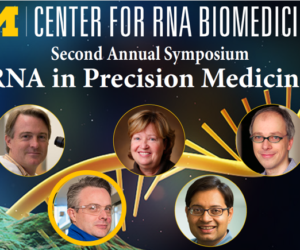“Sequence-based rational design of small molecules targeting RNA”
Keynote Speaker : Matt Disney, PhD
Blogger: Sarah Kearns
Editor: Ada Hagan
Matt Disney earned his bachelor’s in Chemistry at the University of Rochester then went on to University of Maryland for a Masters in Chemistry before returning to Rochester for his PhD in Biophysical Chemistry. Afterwards he did a postdoc at the Swiss Federal Institute of Technology and became an Assistant Professor at SUNY Buffalo. There, he was awarded the Excellent Scholar Young Investigator Award. Currently, he is a principal investigator at the Scripps Research Institute in Florida.
Disney’s research focus is on rational drug design, which is the strategy of creating new molecules with unique functionalities based on the predicted shape of the target. More specifically, his lab focuses on designing very selective drugs that are based on the genome sequence. Within a protein context, it can be very difficult to predict the 3D structure of a complex biomolecule and RNA structure predictions face a similar issue. Moreover, many RNAs can have similar folds making a selective drug hard to identify because many RNA’s with different biological functions can have similar conformations. The goal of Disney’s research is to identify unique patterns in RNA sequence that relate to the 3D structure.
Before we go much further, we must ask ourselves: is RNA a worthwhile drug target?
Historically, RNA has been labeled as “undruggable” since many different types of RNA have similar folds and little surface area for a potential drug to even bind to. Despite these complications, RNA has been implicated in many regulatory roles within the cell, suggesting that RNA has significant biological activity. Moreover, even though an enormous amount of focus is on the proteome (the entire set of proteins within a biological system), only 2% of the genome leads to any protein product. Colloquially, the remaining 98% of DNA has been labeled as junk, but recently this description has been called into question as it has been shown to have crucial roles in DNA regulation through RNAs generated from this “junk” code.
Disney starts his talk by marveling at the fact that the advances in genome sequencing have rapidly outpaced Moore’s Law, which predicts a doubling off events over a decade. Most recent cost estimates are only about 1K per genome. The decrease in cost and increase in available technologies lead to an interest in looking at the proteome, the downstream products of the genome. But as previously mentioned, protein products are relatively small with respect to the products that come from DNA sequencing. Instead, he proposes that more work ought to be done on RNA targeting.
Like proteins, RNA can fold into secondary structures and like DNA, RNA can make base pairs with itself.

RNA folded into a secondary structure with internal base pairs. Source.
Disney’s lab uses a sequence-based approach to design small molecules that target RNA structures. Essentially, he wants to establish a database that identifies what type of small molecules bind to certain RNA motifs (a particular folding pattern or sequence). They were able to do this by probing both RNA space and small molecule space at the same time by incubating RNA with a small molecule of interest. Crosslinking (chemically linking two molecules together permanently) allows for identification and screening to identify an RNA motif with an affinity for a particular small molecule. Competition studies are able to give a gradient of selectivity and affinity per molecule per RNA motif. In other words, he can measure how tightly particular small molecules and RNA structures interact.
In a more applied sense, Disney turns to focus on the dysregulation of miRNA within a cell, which can happen in breast cancers. However, this turns out to be extremely tricky. He asks: do miRNAs have similar motifs? Do different miRNA have identical motifs and if so, how do we target one motif over another?
Through the screen that Disney developed, he was able to identify a set of miRNA motifs that respond to a certain small molecule drug. To confirm that these small molecules actually do bind and inhibit breast cancer propagation miRNAs, they show that both precursor RNA levels and the miRNAs are decreased with addition of the small molecule inhibitor within a cell. This means that the initial genome product is accumulated, but not fully developed to an miRNA.
But drug discovery is never smooth sailing. In this case, the miRNA does not have much surface area for a molecule to bind and therefore is not suitable for further studies. This leads Disney to try to optimize their small molecule.
Because their screening system easily identifies RNA motifs, they hypothesized that they could target two motifs with the same drug and essentially have double the affinity, specificity, and potency. When tested on miRNA-210, whose elevated levels have been implicated in breast cancers, their newly identified RNA-targeting molecule (named Targapemir-210), was shown to inhibit miRNA-210 only in cells that had breast cancer mutations. This implies that their molecule has a good cell environment sensitivity, i.e. it works in diseased cells but not healthy cells.
Disney gives convincing evidence that rational drug design, therefore, is possible even with complicated RNA structures that have very similar structures and motifs.
Disney’s talk was the final in a full day of speakers describing new advances in RNA discovery and technology.
Sarah Kearns is a first year in the Chemical Biology Doctoral Program at the University of Michigan. Currently, she is doing research rotations to find a long-term lab environment ideally focusing on enzyme structure-function relationships for drug development applications. You can find her on Twitter (@annotated_sci), LinkedIn, or at her website Annotated Science.


Leave a Reply